
From
Top Quarks to the Blues
ALS Protein Robots
a Big Hit
From Top Quarks to the Blues
Lab physicists develop way to digitally restore and preserve audio recordings
BY DAN KROTZ
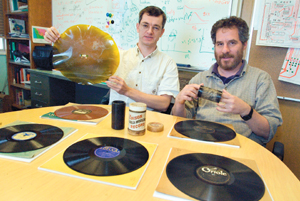 |
|
| Vitaliy Fadeyev (left) and Carl Haber with some of the wax cylinders and acetate and shellac discs that will be studied with methods under development at Berkeley Lab. |
The 1995 discovery of the top quark and singer Marian Anderson’s 1947 rendition of Nobody Knows the Trouble I’ve Seen may seem unrelated. But through an interagency agreement with the Library of Congress, the same technology used to study subatomic particles is helping to restore and preserve the sounds of yesteryear.
“We developed a way to image the grooves in a recording that is similar to measuring tracks in a particle detector,” says Carl Haber, a senior scientist in Berkeley Lab’s Physics Division who developed the technology along with fellow Physics Division scientist Vitaliy Fadeyev.
Their work could ultimately enable the Library of Congress to digitize the thousands of blues, classical, Dixie, jazz, and spoken word recordings in its archives. The mass digitization of these aging discs and cylinders will both preserve the nation’s musical history and make it accessible to a wide audience.
The collaboration takes advantage of Berkeley Lab’s decades of experience developing ways to analyze the flood of data generated by high energy physics experiments. This work, conducted at accelerators located at Fermilab and the European Center for Particle Physics in Geneva, requires the ability to image the tracks made by elementary particles as they hit detectors, and find these tracks amid a jumble of meaningless noise.
“We thought these methods, which demand pattern recognition and noise suppression, could also analyze the grooved shapes in mechanical recordings,” says Haber.
To test their hunch, Fadeyev and Haber turned to a precision optical metrology system used by Berkeley Lab physicists to inspect silicon detectors destined for the upcoming ATLAS experiment, which will search for a theorized but never observed particle called the Higgs Boson. Instead of measuring silicon detectors, however, they programmed the system to map the undulating grooves etched in shellac phonograph discs. The images were then processed to remove scratches and blemishes, and modeled to determine how a stylus courses through the undulations. Lastly, the stylus motion was converted to a digital sound format.
The result is a digital reproduction of a mechanical recording, with each wiggle, bump and ridge in the recording’s grooves faithfully captured, and each scratch ironed out. In this way, The Weavers’ 1950 rendition of the classic Huddie Ledbetter (a.k.a. Leadbelly) song, Goodnight Irene, is closely mirrored — minus the hisses, pops, and scratches. The same goes for Nobody Knows the Trouble I’ve Seen. The nearly 60-year-old mechanical recording sounds worn and scratchy, but the digital rendition rings clear, just as Anderson sang it in 1947.
“We had to use the metrology system in a new way, and measure a groove before we even knew its shape,” says Fadeyev. “This enabled us to develop a non-contact way to measure delicate samples without the need for much operator intervention. It also has the potential to digitally reassemble broken discs.”
Next, Fadeyev and Haber will advance the study of ways to recover damaged and worn cylinders, as well as study the entire three-dimensional profile of a disc’s grooves. Although still under development, the technology could eventually give the Library’s staff a better method to restore some of the 500,000 items it provides preservation treatments to each year.
“The groundbreaking research that our colleagues at Berkeley Lab are undertaking signals an important new direction for preservation of collections of this type, which we hope will be of benefit to libraries and archives everywhere,” says Mark Roosa, the Library’s director for preservation.
In addition to preserving the past, mass digitization gives the public greater access to thousands of old recordings, some so fragile that even the touch of a stylus could damage them. Of course, mass digitization hinges on shepherding the technology far beyond its current research-and-development stage, which is familiar work to Berkeley Lab physicists who have designed and built detectors that have gone on to observe elementary particles like the top quark.
“In the same way, we want to take what we know about audio preservation and help the Library of Congress preserve their collection and make it accessible to the public,” says Haber. “It’s also a good example of how basic research in the physical sciences can benefit other fields of science and culture.”
Berkeley Lab’s Chris Kniel of the Technology Transfer Department helped support the initial phases of this research.
ALS Protein Robots a Big Hit
BY LYNN YARRIS
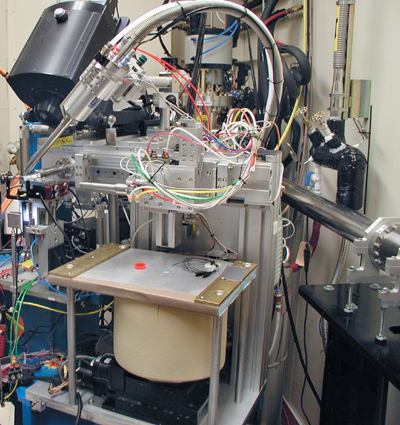 |
|
| Protein crystallography beamlines at Berkeley Lab’s Advanced Light Source utilize automated robots to cut the time required to mount and align protein crystals for study by 80 percent or better. | |
People who think of robots as looking like R2D2 or C3PO of Star Wars fame would be disappointed by the protein crystal automounter robots at Berkeley Lab’s Advanced Light Source (ALS). However, to the protein crystallographers who’ve relied on those robots to mount and align their crystals in ALS beamlines, these machines exemplify the beauty of automation.
With genome sequencing becoming almost a conveyer-belt process, one of the next big challenges in biology is to determine the structures of the proteins being assembled by all those genomes. In the architecturally loopy, twisted world of proteins, knowing structural form is a key to understanding molecular and cellular function. As there may be more than 30,000 different kinds of human proteins, and nearly a trillion different kinds of proteins on Earth, solving protein structures is another process that screams out for automation. With the development and successful demonstration of their automounter robots, Berkeley Lab researchers have achieved a big step towards that goal.
“Thanks to our automounter robots, in less than three years of operation we’ve been able to screen more than 10,000 protein crystals and collect complete structural datasets on several hundred of them,” says Thomas Earnest, a Physical Biosciences Division biophysicist who founded the protein crystallography program at the ALS and who now leads the Structural Proteomics Development Group. Earnest and his group developed the protein crystal automounter robots in collaboration with the bioinstrumentation group of the Engineering Division.
The single most heavily used resource at the ALS is the Berkeley Center for Structural Biology (BCSB), one of the premier facilities for x-ray protein crystallography in the world today. The BCSB now operates eight beamlines, three powered by a multi-pole wiggler and five by superbends, and still there’s a waiting list of users. Any technological development that can shorten the procedure without sacrificing quality is in much demand.
“Speed is the big advantage of automation,” Earnest says. “Whereas it took about 15 minutes to manually mount and align a crystal, we can now do the same thing in less than three minutes using our automounter robots.”
By eliminating the human errors that inevitably set in during a repetitious procedure, and by coupling the robots to a unique software program that enables researchers to cull their best data, Earnest and his colleagues have also been able to improve the quality of the protein crystallography being done at their beamlines.
“We were the first to automate the protein crystal mounting process at a synchrotron light source,” Earnest says. “The technology has proven so successful it is now being exported to protein crystallography beamlines at other synchrotron light sources, including the National Synchrotron Light Source at Brookhaven, the Advanced Photon Source at Argonne, and the Cornell High Energy Synchrotron Source.”
X-ray protein crystallography is the most widely used method today for determining protein structures. A beam of x-rays is sent through a crystallized protein and scattered by the crystal’s atoms, creating a diffraction pattern of dots whose image can be translated by computer into a 3-D model of the protein. With the arrival of synchrotron light sources, enough x-ray diffraction data for imaging a typical protein can be collected within an hour, or even, for some proteins, within minutes — providing you can quickly mount and align the protein crystals in the x-ray beamline.
Enter the protein automounter robot systems being used at the ALS crystallography beamlines. Each system features a liquid nitrogen Dewar that can store up to 112 protein crystals, and a cryogenically cooled, moveable arm, called a “gripper,” that plucks crystals from the Dewar and transports them to the beamline goniometer where the diffraction data is collected. The crystals have to be preserved at liquid nitrogen temperatures (about 100 Kelvin) to minimize any radiation damage that might compromise the integrity of the final 3-D structural model.
“Our automounter robot system looks like a simple procedure, but having to switch from a liquid nitrogen to an ambient environment creates difficulties,” says Earnest. “One of the biggest challenges is reliability. Because everybody’s crystal is important to them, our robots have to be virtually 100-percent reliable.”
To save time for ALS users outside of Berkeley, as well as to further increase their throughput speed, Earnest and his colleagues have also developed special “hockey puck” cassettes, each with an individual capacity of 16 crystal samples. As many as seven can be loaded at once into a standard dry shipping Dewar.
Once the robot gripper loads a crystal into the beamline goniometer,
unique instrumentation control software enables users to position
the crystal in a way that maximizes diffraction data gathering. A
relational database allows users to test and compare crystals for
diffraction quality so that only the best crystal from a sample group
is used for making a 3-D structural model.
The development of this interface software is a collaboration between
Earnest’s group, primarily software engineers John Taylor and
Carl Cork, and the Computational Crystallography Group led by Paul
Adams, a computer scientist with the Physical Biosciences Division,
and the deputy principal investigator of the Berkeley Structural Genomics
Center.
“Incorporating artificial intelligence into data collection, processing and analysis is the next step,” says Earnest. “With the automounter robot hardware, we’ve given this system a good set of arms and legs; now we want to give it a higher level brain. Ideally, the process should be like an assembly line, with crystals coming in, structures going out.”
Details about these automounter robots appear in the April 7 issue of the journal Structure. The paper is titled “Automated Sample Mounting and Alignment System for Biological Crystallography at a Synchrotron Source.” Earnest is the senior author of the paper. The other authors are Carl Cork, Robert Nordmeyer, Earl Cornell, George Meigs, Derek Yegian, Joseph Jaklevic and Jian Jin of Berkeley Lab, plus Raymond Stevens with the Scripps Research Institute in La Jolla, and Gyorgy Snell, with Syrrx, Inc., in San Diego.
This Month in Lab History
Kennedy Stops By to ‘Express His Support’ of Lab Research
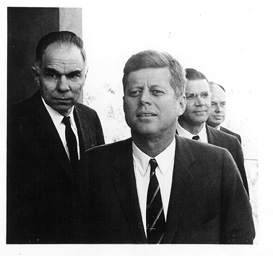 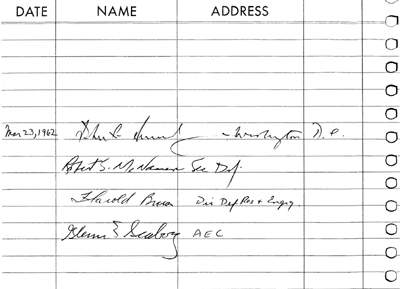 |
|
| Top,
from left to right, Glenn Seaborg, President Kennedy, Robert McNamara,
and Associate Lab Director Harold Fidler (see obituary below). Above, when Kennedy arrived at the Lab, his first order of business was to sign the guest registry. His signature is on the first line, followed by those of Robert McNamara (Secretary of Defense), Harold Brown (Director of Defense Research and Engineering), and Glenn Seaborg (Atomic Energy Commission). |
It was around this time 42 years ago that one of the country’s greatest historical figures made a visit to the Lab — President John F. Kennedy. His trip to the Hill created quite a stir in 1962, which was chronicled in the April issue of the Magnet, the Lab’s employee newspaper.
According to the story, his arrival was preceded by the screaming sirens of a cordon of police motorcycles. This was followed by the president’s sleek blue convertible, which glided to a stop in front of Building 70-A, where he met with a group of Lab scientists.
Though the discussions were “classified,” the president’s press secretary, Pierre Salinger, said: “One of the objectives of the visit is to enable the President to get a briefing on the scientists’ work; the second is to give him the opportunity to express his support of the work that is being done.”
Before and after the 40-minute briefing, Lab “rubberneckers,” as they were referred to in the Magnet story, jostled for positions to take photographs.
One enterprising employee, Sypko Andreae, who was bumped from his Building 70-A office during Kennedy’s visit, scribbled this message on a piece of paper, which he left on his desk:
“Mr. President, welcome to this part of the Lawrence Radiation Lab. If you happen to pass by this desk, please do me the favor of writing your autograph underneath.” When he returned, he saw that Kennedy had complied with his request.
Shortly after his visit to the Lab, Kennedy sent a thank-you note to Lab Director Edwin McMillan. He closed the letter with this: “I wish to thank you and your staff for the courtesies shown me, and I would appreciate your extending my compliments to the laboratory scientists for the excellent job they are doing.”
 |
|
| The Hill was abuzz with activity as Kennedy’s motorcade arrived. | |
Harold A. Fidler, McMillan's Associate Director and Friend of Science Luminaries, Passes at 93
 |
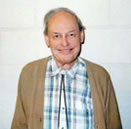 |
|
| Fidler in 1958 (left) and 1991. | ||
The historic photograph (above right) featuring Kennedy, McNamara and Seaborg at Berkeley Lab ran on the front page of the Magnet, the early predecessor of the View, in 1962. It was only after his father died on Friday, April 2, that Don Fidler told the View the photo had actually been cropped. Left on the cutting-room floor was the profile of Harold A. Fidler, long-time associate director under Ed McMillan at the Lab.
Fidler had lived to the grand age of 93 and regularly regaled his family with memories of life on the Hill — the Kennedy visit, another stopover by Queen Frederika of Greece, observing the work of photographer Ansel Adams during a shoot for the University of California. But above all that, his son Don recalls, was Fidler’s memories of the people of Berkeley Lab.
“He was most proud of working with many, many talented scientists with whom he shared a lasting mutual respect,” Don said. “I took him to lunch at Edward Teller’s home several years ago, and they enjoyed reconnecting and reminiscing. Our home would regularly host visits by Edwin McMillan, Glenn Seaborg, Ernest and Molly Lawrence, and many other Nobel Laureates.”
Besides being chief administrator during the “Nobel era” of the ‘60s and ‘70s at the Lab, Fidler added some other significant achievements to his resume — helping to select the name of Centennial Drive, for example, and helping to site what would be Lawrence Livermore National Lab at its current location.
A native Pennsylvanian, Fidler was educated as a civil engineer, achieving a doctorate from the Massachusetts Institute of Technology. Active duty in the Army Corps of Engineers brought him to Berkeley in 1942, when he administered the Army’s contract with the UC Radiation Laboratory. Lawrence recruited him to join the Lab in 1958, and he stayed through 1974, when both he and Lab Director McMillan retired.
He was a man who loved life, according to his son Don, one of his three children by his late wife, Lillian. “He enjoyed challenging his grandchildren with mind-teasers, string games, and other puzzles,” Don said. “Just hours before his death, he was entertaining his hospice nurse with limericks, quoted from a memory that never failed him.”
Berkeley Lab to Celebrate the Earth With Talks and an Environmental Fair
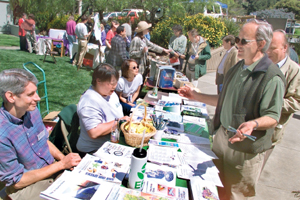 |
|
| The Lab's Environment Fair features information tables on a variety of ecological topics. |
Earth Month — a time when citizens are asked to reflect on the rich resources of the Mother Planet and commit themselves to protecting her land and species — will be celebrated at Berkeley Lab in three special events designed to educate, inform, and stimulate conservation attitudes.
Centerpiece of the series will be an Environmental Fair, back at the Lab after a brief hiatus, on Friday, April 23. More than 20 organizations and agencies will staff tables on the lawn outside the cafeteria during the noon hour, providing information and advice on everything from bicycles to recycling, and from saving the bay to saving energy. The dining hall will offer an outdoor barbecue, and Berkeley Lab’s Music Club will provide entertainment.
The Earth Month program will begin next Wednesday, April 21, when Patti Blasquez, manager of interpretive services for the Lindsay Wildlife Museum in Walnut Creek, will bring her message of wildlife preservation to the Lab community. Her noon talk, which will include live appearances by two birds from Lindsay’s animal collection, will be held in the Building 50 auditorium.
“We’re all part of the circle of life,” Blasquez said of the message she will bring. “We all belong here, and to honor that may require making accommodations in our thinking. We need to learn how to all get along in the great natural world.”
The Lindsay, which also operates the oldest and one of the largest wildlife rehabilitation hospitals in the United States, features 60 species and over 120 animals in its live museum collection. Last year, it attended to more than 6,000 injured animals in its hospital and this year has already treated 650. “Our commitment is to treat native California wildlife through repair, rehabilitation and release,” Blasquez said. “Our survival rate is 40 percent, which is really quite good.”
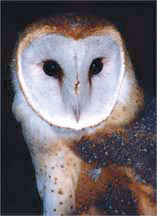 |
|
| Birds from the Lindsay Wildlife Museum will be featured in the April 21 talk. | |
Next year, the Lindsay will be celebrating its 50th anniversary. Blasquez said it all started with a man named Alexander Lindsay, who dedicated himself to teaching neighborhood kids “about the critters that hopped, skipped, jumped and slithered through their back-yards, and how important it was to protect and preserve them,” she said.
On the other side of the Environ-mental Fair, another Earth Month talk will focus on the issue of global warming — in particular, the role that soils play in the carbon cycle. Earth scientist Margaret Torn will be featured in the first-ever off-site Friends of Science event, speaking on Monday, April 26, at 5:30 p.m. in the Berkeley City Library. Her title is, “Bringing Climate Change Back Home.”
Since she was a graduate student at UC Berkeley, Torn’s special research focus has been the relationship of local processes to global phenomena — “how, for example, the methane flux of a single wetland contributes to controlling the temperature of the whole Earth,” she said.
Soils, in particular, are critical to climate change. It’s just not clear in what way. Only the deep ocean stores more carbon than soils. “The central question,” says Torn, “is whether soils will buffer the atmosphere against the massive injections of carbon from fossil fuels and other human activity — or do the opposite, by releasing carbon and greatly amplifying human impacts.”
Admission is free to the Friends of Science talk, and no reservations are required.
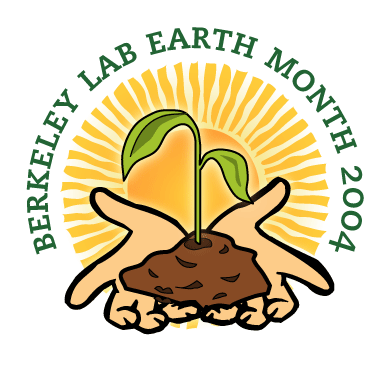 |
|
The Environmental Fair next Friday will provide loads of conservation and action-oriented information from a list of agencies that includes the Sierra Club, the Berkeley Ecology Center, East Bay Regional Parks, the Audubon Society, San Jose Conservation Corps, Boise Cascade, Pacific Gas & Electric, and the Urban Creeks Council.
Participating Berkeley Lab organizations will include the Bicycle Coalition, which is offering free tune-ups; the Green Team, Lab volunteers dedicated to ecological and environmental activities; the Environmental Energy Technologies Division, which will highlight recent lighting and building technologies that promote energy efficiency; the Pollution Prevention Program in Waste Management; and the recently formed Outdoor Club. Rebuilding Together, whose local chapter will be rehabilitating low-income houses in the Bay Area on April 24, will seek Lab volunteers at its table.
Building a Better Landfill
BY DAN KROTZ
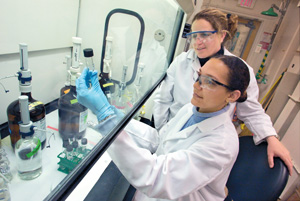 |
|
| Borglin (back) and student researcher Naomi Ndavu look at the microbial communities present in landfills. |
After filling three 55-gallon fish tanks with garbage and watching — and smelling — the trash decay for months, Sharon Borglin knows a thing or two about landfills. And after winning a 2002 DOE Outstand-ing Mentor Award, she also knows what it takes to ensure the next generation of scientists will also study sustainable living.
Over the past few years, Borglin, an Earth Sciences Division staff scientist, has contributed to research concerning landfill management, bacteria that eat hazardous metals, and how man-made endocrine disruptor pollutants enter the ecosystem. Along the way, she’s mentored two college students for several semesters, one of whom has gone on to research wind energy in Southern California.
The fish tanks were part of a project completed last year in which Borglin and colleagues designed and built bioreactors for the study of aerobic and anaerobic landfill processes. Their goal was to learn how today’s landfills, which encapsulate trash in nearly water- and air-tight liners, can be reworked to allow garbage to decay more rapidly.
“Today’s landfills are like placing trash in a Tupperware container, where it slowly degrades over a hundred years,” Borglin says. “In fact, core samples taken at landfills have yielded legible newspapers and intact bananas from 50 years back.”
These dry tombs, as the landfills are sometimes called, date back to the 1970s when the Environmental Protection Agency enacted laws to curb harmful runoff. Although sealing landfills prevents harmful pollutants from escaping, it also stymies degradation.
Now, researchers are learning how to transform landfills from waste preservation systems into bioreactors. In these systems, bacteria — fueled by an influx of air and water — decompose the garbage. To learn more about how they work, Borglin and colleagues developed three lab-scale bioreactors.
“We filled the fish tanks with actual trash brought in from home by ESD volunteers and supplemented it with paper, glass, cans, and leftover food from the cafeteria,” Borglin says. “It sounds silly, but we created garbage.”
In one of the garbage-filled fish tanks they added water, in another they added air and water, and in the third they added nothing. This mimics the different types of bioreactors used in the field: one kind uses only water, which produces methane. Another kind uses air and water, which degrades the garbage more quickly. Then, over ten months, they monitored the rate at which the garbage settled in each tank, an indication of decomposition. Results of their project will be published soon.
“This work could help develop sustainable landfills,” says Borglin. “A lot of landfills today are closed once they are full, and the land can’t be used anymore.”
In addition to landfill research, Borglin is working on a Genomes to Life multi-institutional project that’s examining how certain environmental stresses affect the ability of bacteria to reduce uranium in the environment. This work, headed by Adam Arkin and Terry Hazen of Berkeley Lab’s Virtual Institute for Microbial Stress and Survival, includes studying how anaerobic bacteria react to stresses such as oxygen, and how this affects their ability to reduce uranium and other metals in the environment.
She’s also examining the fate and transport of certain compounds called endocrine disruptors, which are sometimes released from wastewater treatment plants and enter the ecosystem, possibly affecting the life cycle of fish.
Less is More in Waste Management, As Lab Sees Decade of Reduction
BY RON KOLB
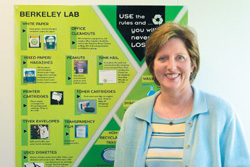 |
|
| Nancy Rothermich | |
When you get a document from Nancy Rothermich’s printer, chances are it will have a bunch of unrelated data and a big “X” on the back side. That’s because she recycles her once-used paper and, because it has a perfectly good blank side remaining, runs it through again.
Call her eccentric, but protect-the-Earth enthusiasts would call
her admirably responsible.
“It’s all part of reducing the environmental impact, and
it’s something we can all do,” says Rothermich, who is
in charge of Berkeley Lab’s Waste Management Program. “It’s
a matter of being vigilant and aware. In the office, the big use problem
is white paper. It takes little effort to save draft paper and reuse
it in a printer.”
So when Waste Management employees bring their children for a visit, you might see them in an office next to the Hazardous Waste Handling Facility (Building 85) removing staples and marking “X” on the used side of paper. Rothermich isn’t above putting the kids to work, in the name of the environment.
Her save-and-reuse attitude extends to the entire Laboratory, where she and her staff of 21 have achieved notable reductions in both the volume and hazard of wastes generated by Berkeley Lab research. Over the past 10 years, hazardous waste onsite has been reduced by 76 percent, mixed waste (a combination of hazardous and radioactive) by 69 percent, and low-level radioactive waste by 77 percent. Sanitary waste (paper, bottles, trash, etc.) is also lower by 70 percent, much of it achieved through recycling.
Much of the credit, she says, goes to the researchers, who have become more open to process changes that help reduce waste generation. Her waste minimization specialist, Li-Yang Chang especially cited the work of the Life Sciences and Engineering divisions for their special commitments to pollution prevention.
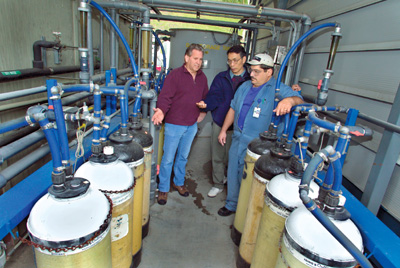 |
|
| Al Harcourt (left), superintendent of the Ultra High Vacuum Cleaning Facility at Building 77, points out a few of the features of a water waste recycling project with Waste Minimization Specialist Li-Yang Chang (center) and Dennis Paiva, operator of the UHVCF and its wastewater treatment process. |
He said since 1996, the Department of Energy has funded 13 projects in Life Sciences for innovative approaches to reducing the use of radioactive materials. Such support is achieved through something called “ROI” — return-on-investment. “The program (sponsored by Environmental Management at the DOE) allowed you to put forward a project; do anaylsis of the time, effort, equipment and supplies required; figure out the waste not generated, and the return on the investment,” Chang said.
That option, he added, is no longer available. But it did result in successful projects such as substituting processes like non-radioactive fluorescence and digital imaging for isotopes, and adding non-polluting machines like molecular and filmless autoradiographic imagers to the research arsenal. In one case, in 1998 an enterprising post-doc, Michael Oda, struck a deal with Bio-Rad for one of its new digital imagers — let us use it, he said, and we’ll tell you how to improve it. Eventually, Berkeley Lab wound up with two of the new imagers at half-price.
The Engineering shops have also been enthusiastic clients for Chang. In one case, a switch from continuous flow to a spray-based rinsing system reduced water use by 40 percent. Another project that closed the water recycling loop in the metal surface cleaning facility cut waste water discharge by one-third and reduced the amounts of sludge and coolant in the waste. Chang credits the leadership of supervisor Al Harcourt and funding from the Lab’s General Plant Projects (GPP) and DOE’s ROI programs for the improvements.
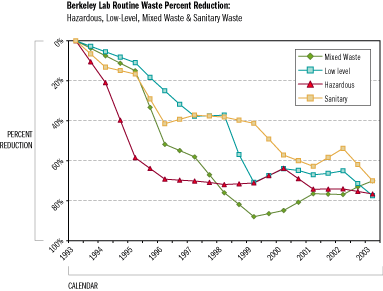 |
|
And there are bound to be more changes as the Department of Energy moves all of its facilities toward something called EMS — the Environ-mental Management System — which Rothermich said is “the future of our waste minimization program.” Chang is working with EH&S Environmental Protection Group Leader Ron Pauer to develop Berkeley Lab’s plan, which is due for implementation in 2005.
“EMS requires that we look at what researchers are doing before they generate the waste, and to look for opportunities to decrease the volume or to use a less hazardous substance,” Rothermich said. “That might mean purchasing a piece of equipment. We will look at the total life cycle of a project, and we can tell management what is needed.
“We’ve been plucking the low-lying fruit to this point,” she added. “When we implement EMS, we can guard against creating unnecessary waste.” It will require a culture change, she said, until “every employee is looking at what they’re doing in their jobs. We don’t need to get to zero (waste production), but we can reduce it as much as possible.”
It is ironic that Rothermich and Chang are in the business of trying to put themselves out of business. No waste, no waste management program. Realistically, such a prospect is unlikely at a large-scale scientific facility like this. But as long as there’s a chance to reduce the environmental impacts of the work, they will work diligently to achieve it. Even if it means running used paper through a printer a second time.
Going Deep to Study Ocean Carbon
BY PAUL PREUSS
A third of the carbon humans put into the atmosphere goes into the world’s oceans, but the situation may not last. Scientists representing seven U.S. government agencies recently released Ocean Carbon and Climate Change, a research plan warning that “feedbacks among climate change, ocean circulation, marine biota, and ocean carbon dynamics” make the future of the ocean’s carbon sink impossible to predict.
Or as oceanographer Jim Bishop of the Earth Sciences Division (ESD) puts it, “We don’t know how the ocean carbon cycle will respond to CO2 in the atmosphere. We don’t even know if the feedback will be positive or negative.”
That’s because, while some pieces of the puzzle are relatively clear-cut — physics and chemistry, for example, can explain why cold ocean waters absorb atmospheric CO2 and warm waters emit it — “we lack a clear understanding of the solar-powered biology of the oceans,” Bishop says. “Without rules for carbon transformation and sedimentation by marine life, we’re flying in the dark.”
Not for long, if Bishop has his way. Satellite monitoring and the remote sensing capabilities of instruments like Carbon Explorer SOLO floats mean “we’re on the cusp of a huge explosion in our ability to follow important, very fast processes in the ocean carbon cycle.”
SOLOs were developed by Russ Davis at the Scripps Institution of Oceanography to report on salinity, temperature, and currents at depths of up to two kilometers; Bishop has equipped them for monitoring carbon as well. “Since 2001 we’ve deployed 12 Carbon Explorers around the world, racking up a total of eight float-years so far. Several are still going strong.”
Unlike shipboard expeditions, the floats are relatively inexpensive, can be widely deployed, and operate continuously for long periods of time, providing unprecedented information about the timing of oceanic processes. Unlike satellites, they see beneath clouds and plunge beneath the surface of the water.
In the spring of 2001, Carbon Explorers observed the first natural fertilization of a plankton bloom in the North Pacific by iron-rich, wind-blown dust from a storm in Central Asia — a phenomenon predicted but never seen before. For several months in early 2002, Carbon Explorers tracked a plankton bloom created by iron fertilization during the multi-institutional Southern Ocean Iron Experiment (SOFeX). Operating far from any manned vessel, the floats recorded the first evidence of carbon exported to the ocean depths by artificially fertilized plankton. (SOFeX results appear in today’s issue of Science.)
In 2003, Bishop and ESD’s Phoebe Lam launched Carbon Explorers in the North Atlantic west of Iceland, one equipped with a new sensor to identify — from the unique optical signatures of their calcite plates — the phytoplankton known as coccolithophores, which form milky blooms tens of thousands of square kilometers in area. “Such prolific blooms can change the upper ocean heat balance,” says Bishop, “by reflecting sunlight and shading organisms lower down. No one has observed such a bloom form or dissipate — they’ve only been seen by satellites when the clouds part.”
The North Atlantic Explorers launched in 2003 are still going strong. In 2004, the researchers plan to study the spring bloom of coccolithophores in the South Atlantic (which comes during autumn in the north).
Simple measurements of carbon flux say nothing about which particles are involved, whether “dead plankton or the leavings of larger animals,” as Bishop puts it, so he and his colleagues are hard at work improving the Explorers.
With funding from the Office of Science, Bishop recently enlisted the Engineering Division’s Zach Radding and Derek Yegian in the design, construction, and testing of an Optical Sediment Trap that makes use of “the kind of components you can find in hand-held computers and consumer digital cameras these days.”
Designed to “bolt onto a SOLO after we’ve lopped its head off,” the Trap uses a funnel to concentrate naturally settling plants, animals, and waste particles on a quartz window, photographing them as they accumulate — then reports the results every 20 minutes, cleans out the sample chamber, and repeats the process. “This will help us understand the food web in the deep sea in real time — the missing piece of the carbon-export process,” says Bishop.
This spring Yegian and ESD’s Todd Wood tested the Trap during a 10-day voyage aboard the University of Hawaii’s Research Vessel Kilo Moana. On the last of eight deployments the float spent 36 hours at depth with no problems, heralding a new generation of sophisticated Explorers.
“I love to build instruments,” Bishop confesses, “but I’m driven by the fact that this is the only way to learn the answers to some fundamental questions” — including the consequences of various carbon sequestration schemes “or the consequences of doing nothing.”
Bishop says, “I’m optimistic that the oceans are resilient. But we’d better find out fast, or we may be in for some nasty surprises.”
Eyes of Texas Upon Carbon Sequestration Test
BY LYNN YARRIS
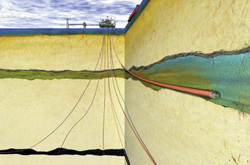 |
|
| This illustration shows CO2 buried in a brine formation beneath a natural gas field in the North Sea. The first U.S. test of carbon sequestration in brine formations will take place at the Frio Formation in Texas. (Image courtesy of Statoil) |
The air is awash in CO2 and it’s estimated that each year we add another seven billion tons of the stuff through the burning of fossil fuels. Scientific consensus says something must be done about this problem, and soon. Looking to be a part of the solution, Berkeley Lab researchers in the Earth Sciences Division (ESD) are playing a key role in a major test for underground carbon sequestration.
Starting this month, some 3,000 tons of CO2, compressed to a liquid, will be injected nearly a mile deep into a brine-saturated aquifer called the Frio Formation, which sits above an abandoned oil field just east of Houston. Researchers with ESD and the Texas Bureau of Economic Geology will spend about a year monitoring what happens to the CO2 plume as it moves throughout the formation, displacing the brine from porous rock. The Frio Pilot Test is the first scientific evaluation in the United States of brine formations as underground carbon sequestration storage sites.
“While we expect the plume to spread out over a few hundred meters, we expect the CO2 to stay buried for thousands of years,” says Larry Myer, a geological engineer with the Earth Sciences Division who leads Berkeley Lab’s participation in this project. “The risk of leakage is a critical factor when storing carbon in brine formations, but I’m optimistic that our test results will show that these formations are safe for carbon sequestration.”
While there’s little danger of a catastrophic escape, Myer says enough small leaks over time would negate the advantages of burying the carbon dioxide underground. Whether the CO2 is buried underground or under the sea, something else has to be done with it other than venting it into the air.
“We already have the technology base for storing CO2 in brine formations because similar injections have been used in enhanced oil recovery operations for decades,” says Myer. “However, we need pilot tests to demonstrate that this approach to carbon sequestration is safe and effective.”
Brine formations represent one of the biggest of all potential underground storage areas for sequestered carbon. In the U.S. alone, there are more than 60,000 of these formations. According to Sally Benson, deputy director for Operations at the Lab, and a prominent national figure in carbon sequestration, “If brine formations are proved to have the capacity that early estimates suggest, they will be able to store hundreds of years worth of CO2 emissions from fossil-fuel power plants.”
Many of the largest of these brine formations run along the Gulf Coast through Texas and Louisiana. The Frio Formation is typical of these formations, made up of alternating and hydrologically isolated deposits of sand and shale. The formation is topped by a thick shale layer that will keep the CO2 buried beneath the surface. Lateral migration will be restrained by a series of faults bordering the formation. According to Susan Hovorks, a state geologist for Texas, the Frio Formation by itself could hold up to 350 billion metric tons of CO2.
ESD researchers will be responsible for the initial hydrologic and geophysical characterization of the test site, which will provide a baseline for subsequent monitoring efforts. They will then deploy such technologies as transient pressure testing, tracers, vertical seismic profiling and Crosswell seismic studies to measure how the CO2 moves through the formation over time after it is injected. Finally, the measurements made at the Frio Pilot Test will be applied to computer models to show what would happen to much larger volumes of CO2 over much longer periods of time.
The Frio Pilot Test will be carried out as part of the Carbon Sequestration Leadership Forum, an international global climate change initiative announced last year by Secretary of Energy Spencer Abraham. It is the first U.S. program under this initiative. The long-term objective of the initiative is to improve carbon capture and storage technologies through coordinated research and development with international partners and private industry.
Facing Up to Climate Change
Margaret Torn explores the impact of global warming
BY PAUL PREUSS
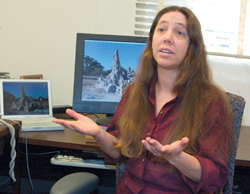 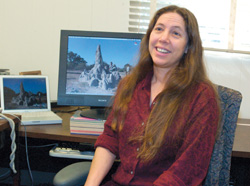 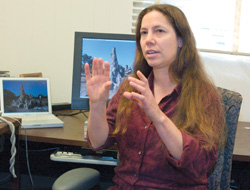 |
|
| Margaret Torn will discuss “Bringing Climate Change Back Home” at the next installment of Berkeley Lab's “Friends of Science” lecture series, to be held on Monday, April 26 at 5:30 p.m. at the Berkeley Public Library, 2090 Kittredge St. | |
Margaret Torn of the Earth Sciences Division warns that global warming is real, and we’d better be prepared. Although her research has taken her to the steppes of Russia, the volcanoes of Hawaii, the tundra of Alaska, and the plains and mountains of the continental U.S., she reminds us that climate change starts at home: how global warming impacts local ecosystems will have dramatic effects for us all.
Born in Southern California, Torn moved with her parents to rural Marin County when she was 11. At the College of Marin she became interested in the interactions of humans and the natural environment; after transferring to UC Berkeley, she received her B.S. with highest honors in 1984, her M.S. in 1990, and her Ph.D. in 1994.
The View asked Torn to discuss the evidence for climate change, some likely consequences, and how scientists are responding to the challenge.
Is global warming real, or is it just something people are scaring us with, to get us to give up our cars?
Torn: There is now an overwhelming scientific consensus that human activities will cause climate change. There may be some small doubt as to whether climate change has already occurred, because it’s a complex statistical problem — whether all the changes in weather across the globe add up to a true signal of global warming. The consensus is based on two different kinds of evidence: predictions of general-circulation climate models and observations of temperature profiles around the world — increases from the surface all the way up into the stratosphere.Then you have all the anecdotal evidence. Glaciers are disappearing. The sea level has risen. The 1990s were the hottest decade — and 1998 was the hottest year — ever recorded.
Do we really have to worry? Sea-level rise, for example, seems like something from a science-fiction movie.
Torn: Coastal real estate is expensive in California, but in most of the world it’s poor people who live in flood-prone areas near the coast. Poor people have fewer options and fewer resources; they will bear the burden disproportionately. It’s not just a matter of building a little sea wall around Malibu. There are whole island nations in jeopardy.Another striking example was last fall’s wildfires in Southern California. (The “Fire Siege” of October 2003 took 24 lives, destroyed 3,710 homes, and blackened more than 750,000 acres.) Evan Mills of the Environmental Energy Techno-logies Division and I worked on a study linking global climate models with wildfire models put together by the state’s Department of Forestry and Fire Protection. It showed that the predicted climate change for a doubling of atmospheric CO2 would lead to a doubling in the number of fires that escape initial suppression — which can go on to become catastrophic fires.
Norm Miller of Earth Sciences has confirmed early projections that one effect of warming in California will be earlier snowmelt — which decreases the snowpack, thus our fresh water supply later in the summer, and increases the potential for flooding in the spring. You get more water when you don’t want it, and less when you do.
Some 80 percent of California water storage is done for us by snowpack, not dams. That’s what I call an ecosystem service, which we’ll lose by changing climate. We haven’t begun to probe how many of these ecosystem services will be affected.
How about the notion that more CO2 could be beneficial to agriculture, that everything’s going to grow faster?
Torn: Yeah, things like Scotch broom, water hyacinth ... It’s true that invasive species and pests often do better in disturbed environments.The most optimistic scenario is that plant and animal species will migrate toward the poles and uphill. That’s optimistic unless you happen to be an alpine species and get squeezed off the top of the mountain. It’s probably true that the wheat belt can expand into Saskatchewan, and that will be for a time beneficial. But the range of malaria mosquitos and agricultural pests will also expand. A lot of them are kept in check by cold.
Tell us something about your current research.
Torn: In Oklahoma we’re concentrating on the complicated problem of measuring and keeping track of CO2 concentrations in the air over continents. We’re working with the Department of Energy’s Atmospheric Radiation Measurement program in the Southern Great Plains to understand the influence of the land surface on the global CO2 levels that are forcing climate change.For DOE we’re also studying how plant-growth allocation affects how much carbon ultimately gets stored in soils. When a soil nutrient like nitrogen is limiting, plants may allocate more growth to roots; if light is limiting, they may allocate more above ground. Because we don’t know much about what goes on below ground, people have tended to assume that roots cycle carbon just like leaves do. It turns out they don’t, they’re really different. Roots can become more stable organic matter.
Most important, we’re working to characterize the feedbacks between climate change and ecosystems — as sources and sinks of greenhouse gases, like CO2 and methane, and how the surface of the land affects things like albedo. These are the key factors in radiative forcing, the basis of global warming.
We need to understand what things can change unexpectedly, given how quickly climate may change. And we need to learn how ecosystem processes may amplify the warming we have started. The time for prevention is now.
Berkeley Lab View
Published every two weeks by the Communications Department for the employees and retirees of Berkeley Lab.
Reid Edwards, Public Affairs Department head
Ron Kolb, Communications Department head
EDITOR
Monica Friedlander, 495-2248,
msfriedlander@lbl.gov
ASSociate EDITOR
Lyn Hunter, 486-4698 lhunter@lbl.gov
STAFF WRITERS
Dan Krotz, 486-4019
Paul Preuss, 486-6249
Lynn Yarris, 486-5375
CONTRIBUTING WRITERS
Jon Bashor, 486-5849
Allan Chen, 486-4210 David Gilbert, 925-296-5643
FLEA MARKET
486-5771, fleamarket@lbl.gov
Design & Illustration
Caitlin Youngquist, 486-4020
TEID Creative Services
Berkeley Lab
Communications Department
MS 65, One Cyclotron Road, Berkeley CA 94720
(510) 486-5771
Fax: (510) 486-6641
Berkeley Lab is managed by the University of California for the U.S. Department of Energy.
Online Version
The full text and photographs of each edition of The View, as well
as the Currents archive going back to 1994, are published online on
the Berkeley Lab website under “Publications” in the A-Z
Index. The site allows users to do searches of past articles.
Flea Market
- AUTOS & SUPPLIES
94 MERCURY VILLAGER Minivan, V6, loaded, pwr everything, 122K mi, exc cond, orig. owner, all records, recent service, $4,500, Bill, X7271, (925) 377-6117
64 FORD F-100 PICKUP, short bed, auto, Dana limited slip rear end, custom cab, new under hood wiring/radiator & much more, requires minor assembly to run, $1,100/bo, Jerry, X4165, 625-9308, 425-4615
MOTORCYCLES
01 CANNONDALE, Bad Boy Rigid XL 20” c-c, 26” wheels w/ street tires, Shimano XL rear derailer, V-brakes, Blackburn rear rack, bar ends, $450, John, X7279
HOUSING
ALBANY, lge 1230 sq ft, elegant, condo, fully furn in secure quiet complex, avail 9/1, swimming pool, 2 bdrm, 2 bth, 2 car garages, exercise rm, nr shops/rest/Bart & Albany schools busing, Geoffry, 848-1830, gfchew@mindspring.com
BERKELEY, house for rent 7/04 & 8/04, dates somewhat flex, $1,400/mo, or $1,100/mo to someone who will look after 6-yr-old lab/husky mix, affectionate, trained, playful, adores children, children welcome, friends will care for dog for occasional overnight absences, house is 2 bdrms, 1 bth, liv, din, kitchen w/breakfast nook, 2 phone lines, DSL, laundry, sml fenced back yrd,, nr UC, close to pub trans/shops, car & bike avail, Jeanne, 843-3171, jpim@uclink.berkeley.edu
BERKELEY, good size rm w/priv entr, nice, quiet, safe residence area, park, tennis court, swimming pool, nr pub trans/ Bart/shops, prefer gentleman, no smoking/ pet, no overnight guest, furn, bed/desk/ sofa & TV, priv entry, fast internet access, priv phone line, washer, cooking util, nr UC, $600/mo+ internet, fees, dep $650, 524-3780
BERKELEY HILLS, 1 bdrm studio in quiet home with sep 1/2 kitchen, sep entr, own bth, share garden, newly painted & refinished wd flr in bdrm, new shower, avail 4/1, $650/mo Bill/Ada, 452 1580
BERKELEY HILLS, 1 bdrm, 1 bth, fully furn inlaw apt, nr Kensington border, quiet neighborhood, priv patio, spacious liv rm, marble bthrm, wall-to-wall carpet, spacious bdrm w/king size bed, fully equipped kitchen, free cable, nr to shops/pub trans, towels & dishes incl, $1,190/mo, $600 dep, no pets/smoking, Ivankash@hotmail.com or Helga, 524-8308 to schedule an appointment
BERKELEY HILLS, by wk/mo, quiet furn suite sleeps up to 3 in 2 bdrm/ 1 bth, quiet, elegant & spacious, bay views, DSL, cable, microwave, nr UCB, Denyse, 848-1830, gfchew@mindspring.com
BERKELEY HILLS, studio, nr LBL/rest/ shops, next to Tilden, La Loma Glendale Park, room 10’x 13’ w/priv entr, lg deck, surrounded by trees, priv bthrm, whte carpet, kitchenette, pantry, microwave, hot plate, sink, new fridge, furn/TV avail, shared DSL/TV cable, no smoking, avail 04/15, $670/mo, 25% of util, sec dep, 1 yr lease pref, pianist in building, Rozalina, 845-4624
CENTRAL BERKELEY, nice furn rms, kitchen, laundry, PC, DSL, hrdwd flrs, brkfst, walk to campus/shops, $800/mo incl everything, 845-5959, jin.young@juno.com, Paul X7363
CENTRAL BERKELEY, nice furn rms, kitchen, laundry, PC, DSL, hrdwd flrs, brkfst, walk to campus/shops, $800/mo incl everything, Paul, X7363, (925) 595-2608, AshleyUlmer@sbcglobal.net
EL CERRITO, fully furn 3bdrm, 2bth house for rent 7/04 & 8/04, $1,500/mo incl util, $500 dep, 20 min to Lab, Art, 237-4654, a.tressler@att.net
HERCULES, 3bdrm, 1bth, newly modeled, lge yrd, garage, close to school/park/ shopping & pub trans, $1,795/mo + dep, no pets, Betty, 245-7517, 642-8638
KENSINGTON, fully furn 3 bdrm home, view, quiet setting, one cat, avail for visiting scientist during summer/fall terms, $1,600/mo + sec dep, Ruth, 526-2007, 526-6730
NORTH BERKELEY, garden cottage, breakfast served daily, $650/mo, 2 suite rms $700/mo, Helen, 527-3252
NORTH BERKELEY by week/mo, fully furn 1/1 flat, quiet, spacious & comfortable, laundry rm, priv garden, gated carport, walk to LBL shuttle/UCB/pub trans, BART, downtown Berkeley, Geoff, 848-1830, gfchew@mindspring.com
NORTH BERKELEY, sunny, quiet 1bdrm, great location, close to UC, hrdwd flrs, fully furn, no laundry facilities, nr to laundry/shops/BART, avail 9/04 to 6/05, $800 per mo, util incl, may not be avail for 10 day period in 12/04, Gail, X4722
NORTH BERKELEY, furn studio, avail 4/2, $950/mo, Rochelle, 548-0431
NORTH BERKELEY, 1bdrm upper flat, fully furn, nr Glendale & Campus Dr, carpeted, laundry, deck, fp, parking for 1 car, no pets/smoking, $1,100/mo + dep & util, avail 4/2, Rochelle, (415) 435-7539
NORTH BERKELEY HILLS,1 bdrm, 1 person garden apt w/fp, off Grizzly Peak Blvd, 1 blk to pub trans, 3 mi to Lab, nr Tilden Park, avail 2/15, $950/mo incl util & laundry, no smoking/pets, 1st+last+sec $250, Barbara/Bill, 524-5780 8am to 9pm
NORTH OAKLAND, sml 1 bdrm cottage, ideal for single person, laundry fac on site, non smoker pref, avail 5/1, $800/mo, incl util, Diane, 652-7080, out of town until 4/24/04, bockarelli@earthlink.net, Liz, X6179
NORTH OAKLAND/ROCKRIDGE, 3 bdrm, 1 bth, stove, refrig, hrdwd flrs & capet, very clean, fenced yrd & patio, bsmt, sep garage, great loc, nr Lake Temescal, lease, $1,675/mo + dep, Al (925) 377-1096
OAKLAND/PIEDMONT, 2bdrm, 1bth, craftsman bungalo fully furn w/stylish trad decor, hrdwd flrs, master bdrm w/queen bd, 2nd rm set up as home office/ sitting rm, lge updated kitchen w/all conveniences, liv rm, fp, lge modular sofa w/ pullout bed, 27” TV, VCR, DVD, satellite, lge back yrd, w/d, central heating, $2,150/ mo for 6/04, 7/04 & 8/04, easy access to all Bay Area freeways, Roman, 601-6031, 915-7222 cell, roman.stearns@ucop.edu
MISC ITEMS FOR SALE
BIKE, BMX 00 Schwinn, auto, great cond, just serviced, $170, Glenn, (925) 360-5869
GUINEA PIGS, 2 very cute, incl cage, water bottle, food dish, exercise wheel, exercise ball, wooden house, extra bedding & food, some feeding containers, $50. Miguel, X6443.
LAWN MOWER, Murray 20, 5.0 HP, 2 yrs old, manual/receipt, $40, Alex, X6849
RADIO, new Kenwood KRC 2006 am/fm, sep bass, treble, Dolby NR, 2 knob shafted for your classic truck or car, adjustable shafts fits most openings, $175 cash or USPS money order, Jerry, X4165, 625-9308 evenings
FREE
PC, 333MHz, 17” monitor, laser printer, Office 2000, Bill, X5632, (925) 935-5004
FOUND
THERMOS, without a cup in 74 lobby next to the water cooler, Helen, X5746
WANTED
BASS PLAYER, high-energy original heavy rock band looking for a strong creative bass player, practice in Concord one night/week, jam/writing + an occasional gig, hoping for talent, input/criticism/ songs/ideas, pro equip, transportation, dependability, Marc, (925) 932-5208, www.DocFreud.com
EXERCISE BICYCLE in useable condition, Dmitry, 525-5500
VACATION
PARIS, FRANCE, nr Eiffel Tower, furn elegant sunny 2 bdrm/1bth apt, avail yr round by week/mo, close to pub trans/shops, Geoff, 848-1830
TAHOE KEYS, 3bdrm, 3bth, luxury waterfront home, dock, spa, gameroom, breathtaking views of Heavenly & Mt. Tallac, access to amenities, Sami (925) 323-8452
Flea Market Policy
Ads are accepted only from Berkeley Lab employees, retirees, and onsite DOE personnel. Only items of your own personal property may be offered for sale.
Submissions must include name, affiliation, extension, and home phone. Ads must be submitted in writing
(e-mail: fleamarket@ lbl.gov, fax: X6641,) or mailed/delivered to Bldg. 65.
Ads run one issue only unless resubmitted, and are repeated only as
space permits. Ads must be submitted in writing and be no more than
50 words in length. The submission deadline for the April 30 issue
is Friday, April 23.